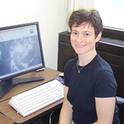
Article
Star formation in M33 (HerM33es)
European Astronomical Society Publications Series
(2011)
Abstract
Within the key project "Herschel M33 extended survey" (HerM33es), we are studying the physical and chemical processes driving star formation and galactic evolution in the nearby galaxy M33, combining the study of local conditions affecting individual star formation with properties only becoming apparent on global scales. Here, we present recent results obtained by the HerM33es team. Combining Spitzer and Herschel data ranging from 3.6um to 500um, along with HI, Halpha, and GALEX UV data, we have studied the dust at high spatial resolutions of 150pc, providing estimators of the total infrared (TIR) brightness and of the star formation rate. While the temperature of the warm dust at high brightness is driven by young massive stars, evolved stellar populations appear to drive the temperature of the cold dust. Plane-parallel models of photon dominated regions (PDRs) fail to reproduce fully the [CII], [OI], and CO maps obtained in a first spectroscopic study of one 2'x2' subregion of M33, located on the inner, northern spiral arm and encompassing the HII region BCLMP302.
Disciplines
Publication Date
2011
Publisher Statement
This paper was harvested from ArXiv.org and ArXiv identifier is arXiv:1105.5219
Citation Information
C. Kramer, M. Boquien, J. Braine, C. Buchbender, et al.. "Star formation in M33 (HerM33es)" European Astronomical Society Publications Series (2011) Available at: http://works.bepress.com/daniela_calzetti/25/
